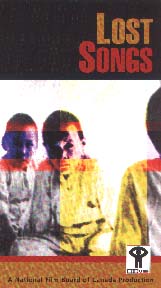| ________________ CM . . .
. Volume VIII Number 4 . . . . October 19, 2001
Although Aboriginal Canadians constitute approximately 5% of the country's total population,
their incidence of tuberculosis is seven times higher. Furthermore, tuberculosis has been an
ongoing health problem: recurrent outbreaks throughout the twentieth century have nearly
destroyed some communities, and, in the 1950's, TB raged at serious levels. Both the old and
young were stricken, and the Government of Canada sought to control the disease by relocating
Aboriginal patients to care and treatment facilities, frequently far from their homes. Given the
isolated nature of many northern communities, and the nature of tuberculosis treatment during
that time, it would seem that few other options existed. Whatever the alternatives, hospitalization
at large urban centers, such as the Charles Camsell Indian Hospital in Edmonton, was usually the
way that cases were handled.
Lost Songs combines the stories
of former patients and relatives of those who died in these facilities,
archival film footage, and still photos detailing life at the Hospital.
Chronic, long-term illness is, in itself, an isolating experience. No
hospital environment ever really feels like home, and, even when family
and friends are near, interaction with them is just not the same as
it is in the day-to-day context of domestic life. Finding oneself uprooted,
cut off from family and a familiar culture, was obviously a hard experience,
and the first-person narratives are often poignant, the memories difficult
to recount. Watching the video, we wonder what led medical personnel
to sanction practices such as "casting"- placing young patients in full
or partial body casts to keep them immobile. Was it callous indifference,
a failure to see their patients as people, or was it the only option
available to keep young, active children from running around and re-infecting
others?
The stories and pictures are haunting,
and it is clear that, for those who spent several childhood years in
these hospitals, there is a tremendous void and loss that persists to
this day. However, as I listened to these stories of lost childhood
or of elders bereft of the opportunity to share their final gifts with
their community, I wondered what else might have been done for them
at that time. That their stories have been told ensures that the songs
are not entirely lost. It takes courage to re-tell the story of a difficult
time in one's youth, and the participants are to be commended for their
courage in facing their memories and sharing them with us. Despite its
merits, I think that Lost Songs has very limited curricular application.
Senior high classes in Native studies might find it offers an interesting
study in the government's health policy towards its Aboriginal citizens.
Preview the film before deciding whether it can be used effectively
in your collection.
Recommended with Reservations.
Joanne Peters is a teacher-librarian at Kelvin High School in Winnipeg,
MB.
To comment on this
title or this review, send mail to cm@umanitoba.ca.
Copyright © the Manitoba Library Association. Reproduction for personal
use is permitted only if this copyright notice is maintained. Any other
reproduction is prohibited without permission.
Published by
TABLE OF CONTENTS FOR THIS ISSUE - October 19,
2001.
AUTHORS | TITLES | MEDIA REVIEWS | PROFILES | BACK ISSUES | SEARCH | CMARCHIVE
| HOME
|
